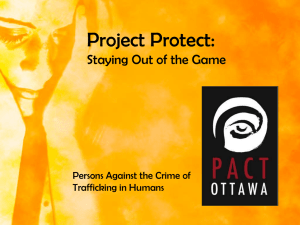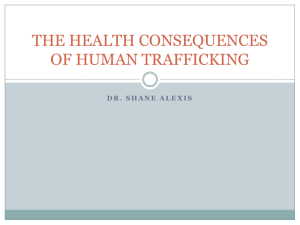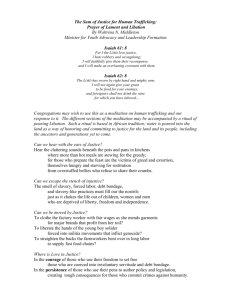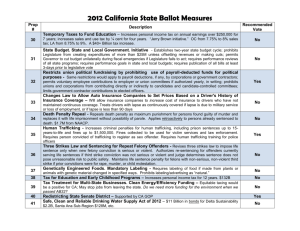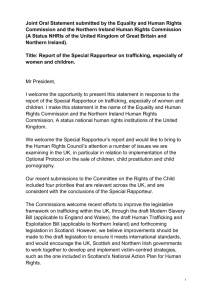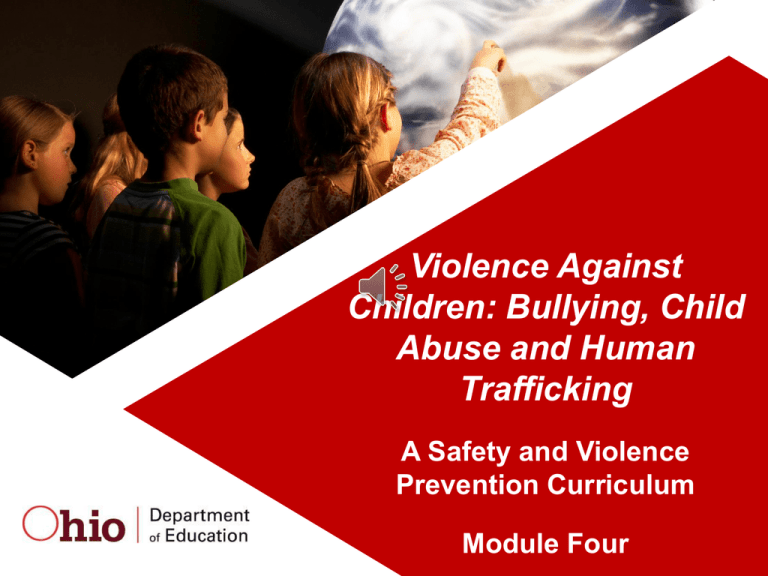
Violence Against
Children: Bullying, Child
Abuse and Human
Trafficking
A Safety and Violence
Prevention Curriculum
1
Module Four
Bullying Defined
Bullying occurs when a child is:
Exposed repeatedly to aggressive actions on
the part of one or more persons;
The child has a difficult time defending
him/herself, due to an unequal distribution of
power (physical, social or relational).
2
Bullying Defined
Bullying can be:
Direct and physical (hitting, pushing, spitting)
Indirect or social (name-calling and rumors)
Relational (using relationships to control)
Conducted in cyberspace
3
Myth or Fact?
A. About 10 percent of youth are involved in bullying as:
– The person who exhibits bullying behavior
– The person who is bullied
– A witness to bullying
B. Girls usually do not bully
C. Bullying is part of childhood; kids will get over it
D. Students do not care about bullying and violence at
school
E. Kids who witness bullying generally ignore it
4
Bullying and Violence
5
Bullying and Violence
Consequences of bullying include suicide,
homicide, depression and self-destructive
behaviors.
Bullying can take place between individual
students or between groups of students.
6
Bullying and Violence
Cyberbullying
from a classmate
or a stranger can
occur anytime
there is access to
cell phones or
the Internet
7
Bullying and Violence
Violence can occur both at school and in the
community. It may be due to:
– Cliques
– Gang activity
– Mental or emotional disturbances
– Social isolation
What are some of the violence issues that
our school and community face?
8
Indicators of Bullying
Avoiding certain situations, people or places, such as
pretending to be sick so the child does not have to go
to school
Behavior changing, e.g., being withdrawn and passive,
being overly active and aggressive, or being selfdestructive
Frequent crying or feeling sad
Signs of low self-esteem
Being unwilling to speak or showing signs of fear when
asked about certain situations, people or places
9
Warning Signs of Violence
10
Aggressive Behavior
Past violent or
aggressive behavior
Bullying or intimidating
peers or younger
children
11
Exposure to
Aggression and Violence
Witnessing abuse or
violence in the home
Being a target of abuse
or neglect (physical,
sexual or emotional)
12
How Should You Respond?
• Identify and name bullying behavior among students–
don’t be a bystander!
• Talk with the student who was being bullied and
assure him or her that you care and want to help.
• Refer the student who bullied to an administrator (per
school policy)
follow-up with school counselor or social worker
about intervention for the student who bullied.
• Refer the targeted student to the school counselor or
social worker for follow-up.
13
Bullying is not a
mediation issue.
You should not try to
mediate bullying.
14
Child Maltreatment
Types of abuse:
•Neglect (of physical, emotional and/or
educational needs)
•Verbal and emotional (name-calling or
disparaging remarks)
•Physical (actions going beyond normally
accepted discipline parameters)
•Sexual (involving sexual gratification)
15
Physical Abuse: Prevalence
3.6 million children
were accepted by
state and local CPS
for investigation or
assessment as alleged
subjects of child
maltreatment.
A third of these cases
were confirmed.
16
Physical Abuse: Affective and
Behavioral Problems
• Those who blame themselves (internalize) may
experience:
– Hopelessness
– Depression
– Low self-esteem
• Those who blame others (externalize) may be:
–
–
–
–
17
Aggressive
Combative
Noncompliant
Defiant
Sexual Abuse
• Sexual abuse includes both contact and
non-contact behaviors:
– Non-contact: exhibitionism, showing pornography
to children
– Contact: kissing, fondling, intercourse
18
Sexual Abuse Prevalence
• Approximately 16% to 20% of female
children and 8% to 12% of male children are
sexually abused each year.
• Girls are more likely to be abused than boys.
• More than 80% of child sexual abuse occurs
between people who know each other;
perpetrated by a family member or trusted
family friend.
19
Development and Communication
Understanding:
• Students’ developmental levels
• Their inability to verbalize what
happened or who the abuser is
• Sometimes children are not believed
• How educators can assist
20
Sexual Abuse: Affective and
Behavioral Problems
• Psychological consequences:
– Anxiety reactions: nightmares, guilt, anger, hostility
– Depression: low self-esteem, suicidal ideation,
social withdrawal, self-injurious behavior
– Eating disorders
– Immaturity
– Hyperactivity
– Substance abuse
21
Sexual Abuse:
Psychosocial Indicators
• Greater awareness of sexuality than would be
expected for the child’s developmental age
• Excessive masturbation or inappropriate sex
play with peers
• Promiscuous behavior
• Sex trafficking of children
– See federal law at
http://www.fbi.gov/hq/cid/cac/federal.htm
(18USC1591)
22
Reporting Child Abuse
Ohio’s educators are mandated reporters of
child abuse. You must report knowledge
OR suspicion.
23
Reporting Child Abuse
Follow local policies:
• What are your school, district and county
policies on reporting child abuse?
Making the report:
• Ask the child protective worker to recite back to
you what he or she has recorded, so that you
can clarify and confirm.
• Child protective services are responsible for the
investigation process.
• Document in writing your interaction with the
child and with child protective services.
24
Student Follow-Up
and In-School Assistance
• You may also be working with students who are not
currently targets of violence, but who have been in
the past.
• These students may need assistance with social
skills, appropriate relationships with others,
concentration, anxiety and depression.
• There are resources in your school district to help
students who need assistance or intervention.
25
Human Trafficking
Definition
Human trafficking is the recruitment,
harboring, provision, or obtaining of a person
for the purpose of a commercial sex act, in
which a commercial sex act is induced by
force, fraud, or coercion and the person
forced to perform such an act is under the
age of 18 years.
26
Human Trafficking
Scope of the Problem
• All 50 states have reported cases of
human trafficking
• 200,000 people have been trafficked in
the U.S. with an estimated 100,000
children involved in sex trafficking.
• In Ohio 50 cases have been reported in
past 9 years with 1,078 U.S. born Ohio
youth sex trafficked in 2011.
27
Human Trafficking
28
Scope of the Problem
• The work or services may include anything from
bonded or forced labor to commercialized sexual
exploitation.
• Studies suggest that up to 90% of runaway youth
become involved in the commercial sex industry.
• There are currently about 700 to 800 active missing
children cases in Ohio, and about 90% are
runaways.
• On average, there are 19,000 to 20,000 missing
children reports per year in Ohio, with about 90% as
runaways. (Missing Persons Unit, Ohio Bureau of
Criminal Investigation)
Human Trafficking
Components of the Business – The Seller
In the business of human trafficking there is the seller,
the buyer and the product or victim.
1.The sellers or trafficker are men and women from all
walks of life.
2.The seller could be an individual or an organized
criminal syndicate that has predatory romantic
involvement with the victim.
3.The seller offers seemingly legitimate work
opportunities for food, housing, clothes, and drugs in
exchange for sex.
29
Human Trafficking
Components of the Business – The Buyer
• The buyers or Johns also come from all
walks of life.
• The buyers feel as if they own the victim they
purchase and subject them to painful,
abusive fantasies.
• The buyers and sellers drive the sex trade
and profit from the demand for commercial
sex.
30
Human Trafficking
Components of the Business – The Victim
• The victim has typically run away or is
homeless.
• Most minor victims “willingly” go with their
trafficker or seller.
• Many minor victims do not think they are a
victim and learn not to trust social services,
law enforcement, etc.
• Online solicitation is increasing with the
use of social media and commercial sex
31
websites.
Human Trafficking
Components of the Business – The Victim
• The average age that a person first enters
into the commercial sex industry is 12-14.
• Victims of human trafficking are not
permitted to leave upon arrival at their
destination.
• They are held against their will through acts
of coercion and forced to work or provide
services to the trafficker or others.
32
Human Trafficking
Factors associated with human trafficking of
minors are:
• Presence of pre-existing adult prostitution
markets in communities where large
numbers of street youth are concentrated.
• Prior history of child sexual abuse and
child sexual assault.
• Large numbers of unattached and
transient males including military
personnel, truckers, and conventioneers.
33
Human Trafficking
Factors associated with human trafficking of
minors are:
• Membership in gangs, runaways and
homeless youth
• Recruitment by organized crime groups.
• Possesses large amounts of cash and hotel
room keys.
• Has unexplained school absences and is
unable to attend school regularly.
34
Human Trafficking
35
Factors associated with human trafficking of
minors are:
• looks like a minor, while claiming to be adult
• has indicators of being “branded” (e.g.,
having a tattoo).
• lies about her/his age and/or possesses
false identification
• tells life stories with inconsistencies
• has little knowledge of his/her community or
where he/she is
Human Trafficking
Factors associated with human trafficking of
minors are:
• Minor is involved with abusive or controlling
partner/”boyfriend”
• Minor has signs of physical abuse and/or
injury
• Minor appears to be engaging in scripted
communication
• Minor has fearful or anxious demeanor
36
Human Trafficking
Factors associated with human trafficking of
minors are:
• Minor appears hungry and/or malnourished
• Minor wears clothing that is not appropriate
based on season or weather
• Minor appears addicted to drugs
• Minor shows shift in behavior, dress, or
belongings, such as sudden possession of
expensive items
37
Human Trafficking
Factors associated with human trafficking of
minors are:
• Minor has unexplained school absences;
unable to attend school regularly
• often runs away
• talks about traveling to other locations
• shows signs of physical abuse
• Is withdrawn, fearful, and/or depressed.
38
Human Trafficking
Factors associated with human trafficking of
minors are:
• does not have control over his/her own
schedule
• does not have control over his/her ID forms
• Minor talks about sexual activities that
exceed age-group norms
• Minor is involved with “boyfriend” who is 10
or more years older than potential victim
39
Human Trafficking
Solutions
• Parents, educators and community
members should model healthy
relationships and create environments that
counter risk factors.
• To prevent minors from participating in
human trafficking, educators can draw on
local violence prevention agencies to
access effective prevention programs and
best practices.
40
Human Trafficking
Solutions
• Adults can contact their local coalition or violence
prevention organization to have a speaker talk with
students about avoiding the exploitation and violence
against minors.
• To intervene and report human trafficking of minors,
adults can contact their local law enforcement,
county children services, local Rescue & Restore
Coalition and the National Human Trafficking
Resource Center at 1-888-373-7888.
41 • Call 911 (if in immediate danger).
Human Trafficking
Resources
Ohio Human Trafficking Commission:
http://www.ohioattorneygeneral.gov/HumanTrafficking
Ohio Department of Education
www.education.ohio.gov
and search keywords Human Trafficking
42
The Big Picture:
School Climate
• Effective school safety programs build a school-wide
foundation for all children. This involves:
– Supporting positive discipline, academic success and
mental and emotional wellness through a caring school
environment;
– Teaching students appropriate behaviors and problem
solving skills;
– Providing positive behavioral support;
– Delivering appropriate academic instruction with engaging
curricula and effective teaching practices; and
– Training staff to recognize early warning signs and make
appropriate referrals.
43
What Can You Do?
IDENTIFY students who are
experiencing barriers to learning.
REACH OUT: Tell them you care and
want to help.
REFER students to in-school staff or
community resources.
44
For More Information
education.ohio.gov
45
Click on the link below to access the Google Drive
Survey for this final module. Once again you will
be prompted to sign into you account.
• https://docs.google.com/a/elginscho
ols.org/forms/d/1mThRSKgQIjk5a87PFor3jA_aqx9hbap
ZXcyRl-qxXs/viewform
46
@OHEducation
ohio-departmentof-education
OhioEdDept
Ohio Teachers’
Homeroom
47

